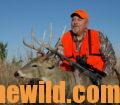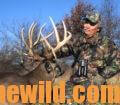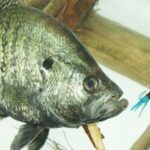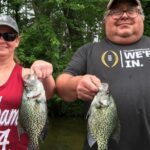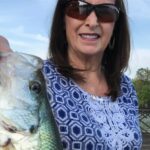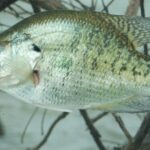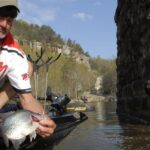Editor’s Note: When you first fall out of a tree and before you hit the ground, you have plenty of time to think about how stupid you’ve been, the mistakes you’ve made, and what you should have done to prevent the beating you’re about to take. I know from firsthand experience. I’ve fallen from tree stands on four different occasions, although not in recent years. The bruises, scratches, scrapes and loss of breath finally have taught me how important learning tree-stand safety is and how to keep from falling when I climb.
The safest types of ladder stands are the ones with a brace about six feet up in the middle of the ladder to brace the center of the ladder to the tree. This brace usually can be secured to the tree before you begin to climb the ladder. Also have a strap or a chain at the top of the ladder stand to secure the stand to the tree. Most deer hunters like ladder tree stands with belts and ratchet systems to allow them to not only secure a ladder type stand to the tree but also actually pull the stand in tighter to the tree and make the stand more secure. Remember, when you get to the top of the ladder to fasten your safety belt to the tree to prevent your possibly falling from the ladder.
Safety Belts and Harnesses:
All types of safety belts are available on the market today. The most-common belt is a wide nylon strap that can be secured to the tree and then slipped over your head and secured to your chest. These belts are lightweight and easy to use and will prevent you from falling to the ground. However, from field testing these kinds of belts, I’ve also learned they have some inherent problems. 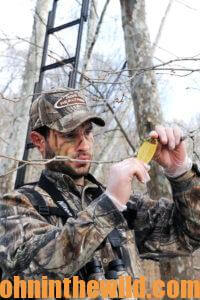 Many hunters put the belts around their waists instead of around their chests. If you slide the belt around your waist like a hangman’s noose, then when you fall that belt will continue to tighten up and squeeze you in the middle. Also, if you use a safety belt attached only at your waist, if and when you fall, there’s a good chance you may hang upside down in the tree.
Many hunters put the belts around their waists instead of around their chests. If you slide the belt around your waist like a hangman’s noose, then when you fall that belt will continue to tighten up and squeeze you in the middle. Also, if you use a safety belt attached only at your waist, if and when you fall, there’s a good chance you may hang upside down in the tree.
Although hanging upside down is uncomfortable, righting yourself can be almost impossible. If you don’t fall to the ground, you may have incurred another problem – how to get out of your safety belt when you’re upside-down. To solve this problem, grab hold of the tree with your arms, and right yourself. Next, wrap your arms and your legs around the tree, and climb up to loosen the belt. Continue to climb up or down until you reach your stand or the ground. I’ve learned I’m less likely to hang upside down when I use a safety belt that only wraps around my chest.
Another advantage to wearing a safety harness – my favorite is the Hunter Safety System (https://huntersafetysystem.com/) – is I feel much more secure with the shoulder straps and the waist strap when I have to lean out from the tree to take a shot with my bow than I do when I lean out with only a chest strap to secure me to the tree. Too, when wearing a harness, if you take a deer, dragging the animal out with the harness is easier than trying to pull the deer out by either his antlers or his legs. By attaching the strap that is designed to go around the tree instead to the deer’s head or antlers, you can stand upright and lean forward, straining against the harness, to drag the deer out. This type of harness allows you to use your back and leg muscles to pull the deer and frees-up your hands to carry your gun and/or other equipment. Although I’m sure there are other fine safety belts on the market, I have found this safety-type harness to be the most comfortable and user-friendly type of safety belt/deer drag available.
Brenda Valentine on the Value of Wearing a Safety Harness:
My longtime friend, the First Lady of Hunting, Brenda Valentine of Puryear, Tennessee, tells why she’s such a big believer in wearing a safety harness, rather than a safety belt. “I was hunting near my home and was using my climbing tree stand to climb a big red oak tree. I was trimming limbs off the tree as I climbed it. I had one of those old-style safety harnesses that went around your chest but didn’t have leg loops. But I failed to attach the harness to the tree, because back then you didn’t attach yourself to the tree, until you were at the height at which you planned to hunt.
“I was about 12-feet high. To continue to climb the tree, I had to saw through a limb about 12 inches in diameter. The top of this limb was pulled down by some vines. So, when I finally sawed 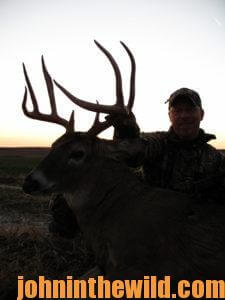 through the limb, the limb sprang toward me, hit me in the chest and knocked me backwards. However, my feet still were in the straps on the bottom of the climbing tree stand. This tree stand was one of those where you put your feet in the straps on the base of the platform, bear-hugged the tree, pulled your legs up to pull up the tree stand and then pushed down to lock the stand back into the tree. When I got knocked off the tree stand, I dangled upside down with my feet still attached to the stand. I had the breath knocked out of me too. I couldn’t sit up or find anything to pull myself up with to get back on top of the stand.
through the limb, the limb sprang toward me, hit me in the chest and knocked me backwards. However, my feet still were in the straps on the bottom of the climbing tree stand. This tree stand was one of those where you put your feet in the straps on the base of the platform, bear-hugged the tree, pulled your legs up to pull up the tree stand and then pushed down to lock the stand back into the tree. When I got knocked off the tree stand, I dangled upside down with my feet still attached to the stand. I had the breath knocked out of me too. I couldn’t sit up or find anything to pull myself up with to get back on top of the stand.
“My first thought was that I had broken both of my ankles. Since I was upside down, I’d pass out and then return to consciousness. I tried to understand what was happening, and my next thought was, “I’m probably going to lose my legs, since I don’t have any circulation from my knees down.” I struggled and struggled to get myself back up on top of that platform, because I realized no one knew where I was hunting. I had neglected to tell anyone or leave a note.
“I finally took a deep breath and thought to myself, ‘I’m going to die right here, hanging upside down from this tree stand.’ I wasn’t really that afraid of death. But when I began to think about my family finding me after the crows and buzzards had started eating on me, I knew I had to get out of that tree stand. I gained enough strength to start swinging back and forth and got hold of a vine hanging down off another tree. I had a little pouch on my climber, and I knew there was a small knife in it. I got hold of the little pouch, ripped it open, removed the knife, opened the knife’s blade and began swinging back and forth once more, until I came up high enough to stab between the place where the strap was attached to the platform and then went around my boot. Then I’d fall back down, regain my strength and make another giant swing to stab the strap. The strap finally broke, I fell backwards, and I dropped the knife. Dangling now from one leg, I thought, ‘Oh, my goodness, I’m in worse shape now than when I was hanging by two legs.’ I continued to swing and wiggle, until I got my foot out of my boot that was still attached to the tree stand.
“Once I hit the ground, I laid there for awhile, realizing I couldn’t walk. So, I crawled 1/2-mile back home on my belly. I banged on the back door until my husband left the football game he was watching and carried me to the hospital. Luckily I only broke three ribs, however, I had stretched all the tendons and ligaments in my legs so badly, and my ankles were so swollen, that I had big blobs of gelled-up blood in my ankles. After my recovery, I repaired my tree stand and went hunting again from that stand before the end of the season. However, this time instead of wearing boots to hunt, I wore tennis shoes with no strings in them. I also kept a knife on my belt.
“From that experience, I learned the importance of always being attached to a tree, whether I was climbing up or down. I also learned not to saw limbs that could kick back and knock me out of a stand. Some lessons we learn easily; other lessons we learn only through pain and suffering. I became the very first pro hunter on the Hunter Safety System team.

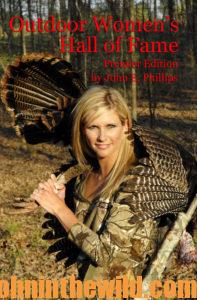 To learn more about hunting deer, check out John E. Phillips’ book, “How to Hunt and Take Big Buck Deer on Small Properties,” available in Kindle, print and Audible versions at (http://amzn.to/1vIcj4m). Also look at John E. Phillips’ book, ”Outdoor Women’s Hall of Fame, featuring Brenda Valentine and 13 other top lady hunters, including Taylor Drury, Eva Shockey and Vicki Cianciarulo, and available in Kindle and print at http://amzn.to/2AlVYJE.
To learn more about hunting deer, check out John E. Phillips’ book, “How to Hunt and Take Big Buck Deer on Small Properties,” available in Kindle, print and Audible versions at (http://amzn.to/1vIcj4m). Also look at John E. Phillips’ book, ”Outdoor Women’s Hall of Fame, featuring Brenda Valentine and 13 other top lady hunters, including Taylor Drury, Eva Shockey and Vicki Cianciarulo, and available in Kindle and print at http://amzn.to/2AlVYJE.
Tomorrow: How Avid Deer Hunter Stan Potts Picks His Tree Stand Sites

